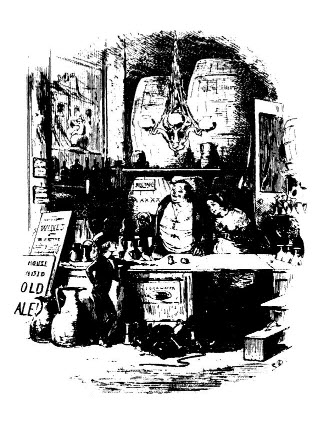For a school assignment, my high school junior recently had me get a copy of Fast Food Nation, Morgan Spurlock's account of putting himself on a fast-food diet and checking out the results.

If you happened to miss the book and the subsequent movie, here is the summary (spoiler alert!): fast food turns out to be not so good for you.
No big surprises there, but all the persuasive books in the world can't prevent my occasional cravings. We went to a potluck wedding a month ago, and what did I lunge for? The bucket of Kentucky Fried Chicken, naturally. Hey--I get homemade food all the time, but sometimes you just want the Colonel's eleven herbs and spices. And if French fries appear in a three-foot radius of me, watch out.
Not having the time, inclination, skills, or equipment necessary to cook your own food isn't a new problem, it turns out. Or, at least, it isn't a problem that only developed in the '60s and '70s, when women left the homefront and entered the workforce. Fast food, it seems, began as a Victorian phenomenon.

As a major 19th century British literature fan, this was a fascinating read. And, as a food obsessive, the chapter "Feeding the Streets" was doubly interesting. Why exactly did David Copperfield go into a pub and get a pint of ale for breakfast? Well, when the options are crappy, untreated water or ale or beer made from boiled water, go for the ale or beer. It's not fresh-squeezed o.j., but at least it won't give you cholera.
Victorian London was teeming with people, people, and more people, jammed and crammed in dicey neighborhoods (most without kitchen access), and all those folks needed food. From early morning when everyone walked to work or waited in omnibus-clogged traffic jams, to late at night after the theaters got out, fast food could be found on the streets.
In the mornings there were pastrycooks offering penny loaves of bread or slices of "pudding" (like a bread pudding). Consider this recipe cadged from Recipes Past and Present:
Bachelor’s Pudding
- Four ounces of flour
- Four ounces of raisins
- Four ounces of suet
- Four ounces of Demerara sugar
- Four ounces of breadcrumbs
- Two ounces of butter
- Two eggs
- Half a teaspoonful of baking powder
- Half a teaspoonful of ground ginger
- A little milk
Method; Rub the butter into the flour, mince the suet, stone and divide the raisins, mix all together, add the sugar, breadcrumbs, baking powder, ginger, eggs [beaten] and milk, mix thoroughly. Butter well a mould; entirely cover the inside with brown sugar, pour in the mixture, cover with buttered paper and steam for two hours. Note to make the pudding less rich leave out the butter.
If it's got suet, you know it's gotta be good.
Street-sellers sold coffee, shellfish, meat, hot potatoes. A favorite offering was hot eels, "which were cheap and, because of their gelatinous consistency, filling." Then there were the cheap oysters, four for a penny, "opened, vinegared and peppered."

And, of course, there were the muffin men (as in, "Do you know the etc.") and the pie men. Not being generally tempted by eels and oysters, I would have hung around the pie man's stall, but, then as now, people were known to cut corners and scrimp on costs and quality ingredients in their processed foods:
To maintain their price at the expected penny, the piemen were forced to scrimp: their pies were made with cheap shortening, or had less filling, or poor-quality meat. Many of the legends of cats'-meat, or worse, in pies spring from this period. In 1833, Sam Weller advises the horrified Mr. Pickwick, 'Wery good thing is weal pie, when you...is quite sure it ain't kittens.'
Nowadays we might avoid the pies for the hydrogenated fats, and we still know the disappointments of skimpy pie filling, but at least we are spared the cats.
On the plus side, fresh and seasonal were givens. Gooseberries and strawberries in summer, hot green peas at Easter, hot elder wine and pease pudding in winter. And as for beer, you only had to leave your pot hanging on your railing and potboys from the nearby pub would come by and fill it on weekday evenings. Like having your own milkman, but for beer.

If you had a little more time and money to eat, you could bypass the fast food offered at street stalls for a coffee house, soup house, or chop house. The last option served meat, bread, and half a pint for sixpence. And then there was the wonderfully named "slap-bang" aimed at poorer Victorian clerks with only a 15-minute lunch "hour." You hung up your hat, sat down, ordered, bolted your food, paid, and ran back to work.
And finally, for those for whom fast food wasn't fast enough, waiters could deliver food to office workers. I guess the sad practice of eating at your desk isn't something we invented this century either!
Nor were the ill effects of all that fast food just a modern consequence. As Morgan Spurlock discovered, too much low-quality food on the run wreaks havoc with your vitals. In Dickens' time, if you made it to the age of 16 without managing to die from the cornucopia of mortal diseases, your average life expectancy was 58. If you made it to 25 without mishap, you might eventually reach 61. Dickens himself only made it to 58, which doesn't sound old at all nowadays, but, really, that's a lot of stewed eel and cat's-meat pie.




